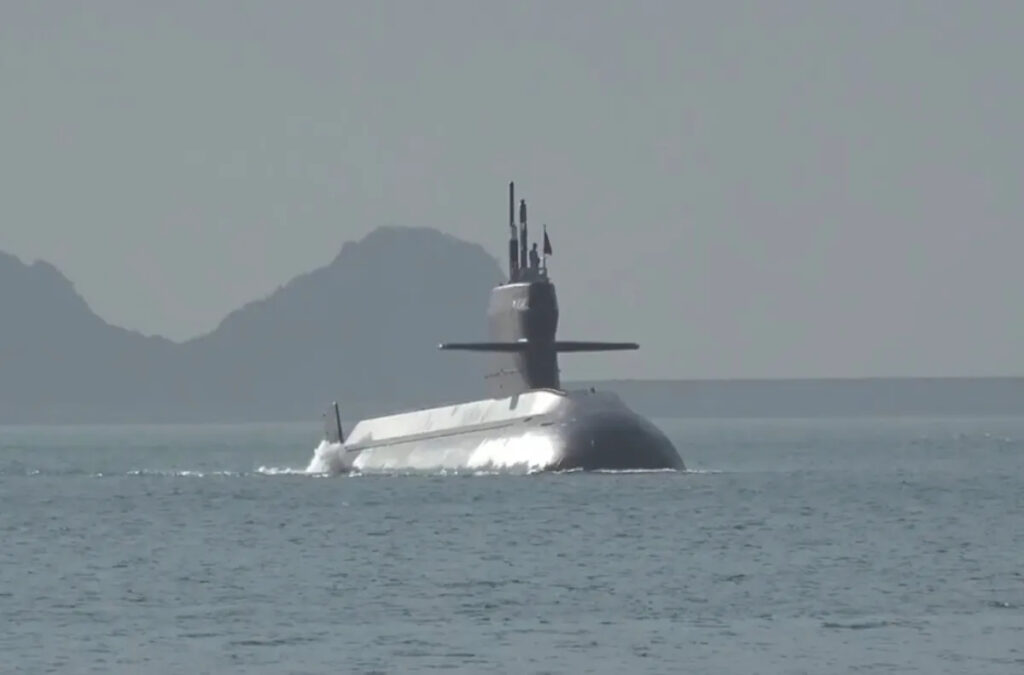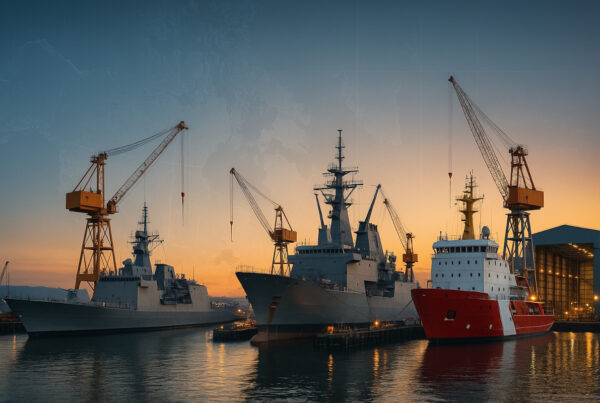New conventional sub appears to include vertical launch system and is built for unique demands of Taiwan Strait and South China Sea

A new submarine commissioned by the Chinese People’s Liberation Army (PLA) Navy enters operation at an undisclosed date. The submarine has been dubbed the Type 039C by overseas media. Photo: Screenshot from the official Weibo account of the PLA Navy.
(Written by Gabriel Honrada. Published here in Asia Times, republished with permission.)
China’s stealthy launch of an advanced submarine underscores its escalating drive for underwater dominance in the increasingly tense waters of the Taiwan Strait and South China Sea.
This month, Naval News reported that a Chinese shipyard in Wuhan launched a new advanced non-nuclear submarine, marking a significant advance in China’s naval capabilities.
Naval News mentions that the submarine, which is larger than its predecessors and features innovative X-form rudders, was revealed by naval expert Tom Shugart in July after its unpublicized launch in April 2024.
Significantly, the source says the vessel may include a vertical launch system (VLS) for missiles, a feature uncommon in non-nuclear submarines. This addition could potentially equip the submarine with anti-ship ballistic missiles or land attack missiles, enhancing its combat potential.
Naval News mentions that the submarine’s design suggests it is a derivative of the Type-039A-C Yuan class, currently in service with the People’s Liberation Army–Navy (PLA-N). The report says the secrecy surrounding the launch and the submarine’s capabilities reflects China’s discreet approach to military advancements.
Naval News states that the emergence of this submarine, if confirmed to have a VLS, could challenge the perception of China’s conventional submarine force as being of only local relevance, signifying a possible leap in reach that will add to China’s growing naval might.
Asia Times mentioned this month that the X-form rudder of China’s new submarine suggests significant gains in maneuverability and stealth capabilities, crucial for operations in the Taiwan Strait and South China Sea.
Despite China’s ability to build nuclear submarines, the focus on conventional boats reflects a strategic approach tailored to the unique operational demands of China’s maritime environment.
The US Department of Defense (DOD) anticipates a considerable expansion of the PLA-N submarine fleet, with estimates suggesting an increase to 65 units by 2025 and 80 units by 2035.
This growth is attributed to China’s growing submarine construction capacity and the introduction of advanced anti-ship cruise missiles on conventional submarines.
Victor Sussman mentions in an October 2019 Proceedings article that adding VLS to submarines enhances their offensive capabilities against well-defended surface combatants.
Sussman points out that during the Rim of the Pacific 2018 naval exercise, the USS Olympia successfully utilized a submarine-launched anti-ship cruise missile (SLASCM), underscoring the strategic value of stealthy submarines as formidable ASCM platforms.
He mentions that the possible integration of VLS-compatible missiles could significantly increase submarine salvo size, offering a tactical advantage in saturation attacks. Such missiles currently in Chinese service include the YJ-18 ASCM, CJ-10 land attack cruise missile (LACM), and the YJ-83 ASCM.
Sussman emphasizes the importance of numerical superiority in salvo exchanges, suggesting that larger salvos improve the likelihood of neutralizing enemy units.
He notes that the future of submarine warfare is poised for a transformation, with VLS-armed submarines positioned to deliver more effective first strikes and maintain a tactical edge in the increasingly contested maritime domain.
China’s rapidly advancing conventional submarine fleet enables it to carry out complex blockades and first strikes, potentially altering the balance in a Taiwan conflict and complicating allied intervention.
In a Baker Institute report this month, Gabriel Collins and Andrew Erickson mention that China’s conventional submarines would play a crucial role in establishing maritime control and exerting strategic pressure on Taiwan and its allies in a potential conflict over Taiwan.
Collins and Erickson suggest stealthy submarines could be crucial in isolating Taiwan and deterring foreign intervention, complicating efforts to secure communication lines.
They say China’s submarines could disrupt Taiwan’s supply movement and enhance its anti-access/area denial (A2/AD) strategy, making it harder for the US and its allies to intervene effectively in the Taiwan Strait.
In the South China Sea, Edward Feltham mentions in an October 2023 article for the Naval Association of Canada that China’s conventional submarines play a critical role in its maritime strategy, particularly in executing a sea denial strategy within the First Island Chain.
Feltham says that the PLA-N’s modernization has significantly focused on enhancing the capabilities of its diesel-electric submarines (SSKs), such as the Yuan-class, which are equipped with advanced Air-Independent Propulsion (AIP) systems.
He notes that submarines are designed for operations in the shallow, contested waters of the South China Sea, where their stealth and endurance are highly advantageous.
He points out that the primary role of these submarines would be to prevent adversaries from gaining control over critical maritime areas, using torpedoes and anti-ship cruise missiles to target enemy vessels.
Feltham also mentions that they could be deployed for intelligence gathering, surveillance and covert operations, providing China with a potent deterrence and active engagement tool.
As China’s submarine fleet expands to assert dominance in its adjacent waters, regional powers are rapidly bolstering their underwater capabilities, setting the stage for an underwater arms race.
In a June 2024 article for Breaking Defense, Christopher Woody mentions that countries across the Indo-Pacific region are intensifying their focus on undersea warfare capabilities in response to China’s rapid military modernization, particularly its expanding submarine fleet.
Woody says that Taiwan’s unveiling of its first domestically assembled Hai Kun-class submarine, with the assistance of undisclosed foreign partners, marks a significant step in its efforts to bolster defenses against potential Chinese aggression.
He notes that the diesel-electric Hai Kun is equipped with torpedo tubes for Mk 48 torpedoes and Harpoon anti-ship missiles, and future models may include submarine-launched anti-ship missiles.
Furthermore, he says Japan continues to showcase its shipbuilding prowess by commissioning its latest Taigei-class diesel-electric attack submarine, the JS Jingei, featuring stealthier designs, enhanced sensors, and lithium-ion batteries for improved endurance.
Likewise, he notes that South Korea’s new ROKS Shin Chae-ho, part of the Dosan Ahn Changho class, boasts advanced features like domestically developed fuel cells and an AIP system, enhancing its submerged operational capacity.
Woody mentions that Southeast Asian nations are also advancing their submarine capabilities. He notes that Singapore launched the last of its Invincible-class diesel-electric submarines, designed for the region’s unique maritime environment.
He also says the Philippines and Indonesia have initiated steps to acquire new submarines, reflecting a broader trend of regional militaries investing in undersea assets as a strategic hedge against geopolitical uncertainties and maintaining parity with neighboring fleets.
He notes that this collective submarine buildup underscores the strategic importance of undersea warfare in a region where sea access is paramount. According to Woody, these submarines serve as a deterrent and counterbalance to China’s growing naval power.
Woody also points out that this trend highlights the role of submarines as both a defensive measure and a symbol of naval prestige in the Indo-Pacific.








